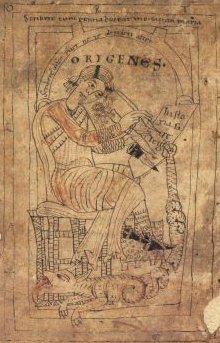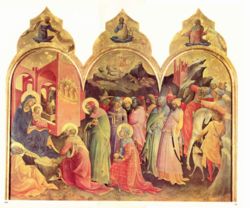Christmas: Difference between revisions
imported>Larry Sanger No edit summary |
imported>Peter Kauffner |
||
| Line 57: | Line 57: | ||
In 1914, the first year of [[World War I]], there was an [[Christmas truce|unofficial truce]] between German and [[British Army|British troops]] in France. Soldiers on both sides spontaneously began to sing carols and stopped fighting. The truce began on Christmas Day and continued for some time afterwards.<ref>Baker, Chris, [http://www.1914-1918.net/truce.htm The Christmas Truce of 1914], 1996</ref> Many stories about the truce include a [[football (soccer)|football]] game between the trench lines. | In 1914, the first year of [[World War I]], there was an [[Christmas truce|unofficial truce]] between German and [[British Army|British troops]] in France. Soldiers on both sides spontaneously began to sing carols and stopped fighting. The truce began on Christmas Day and continued for some time afterwards.<ref>Baker, Chris, [http://www.1914-1918.net/truce.htm The Christmas Truce of 1914], 1996</ref> Many stories about the truce include a [[football (soccer)|football]] game between the trench lines. | ||
Throughout the 20th century, the United States experienced controversy over the nature of Christmas, and its dual status as a religious feast day and a secular holiday of the same name. Some considered the U.S. government's recognition of Christmas as a federal holiday to be a violation of the [[separation of church and state]]. This was brought to trial several times, recently including in ''Lynch v. Donnelly (1984)''<ref name="Lynch">[http://www.belcherfoundation.org/lynch_v_donnelly.htm ''Lynch vs. Donnelly''] (1984)</ref> and ''Ganulin v. United States (1999)''.<ref name="Ganulin"> [http://www.becketfund.org/index.php/case/25.html ''Ganulin v. United States''] (1999)</ref> On December 6, 1999, the verdict for ''Ganulin v. United States (1999)'' declared that "the establishment of Christmas Day as a legal public holiday does not violate the Establishment Clause because it has a valid secular purpose." This decision was upheld by the [[Supreme Court of the United States|U.S. Supreme Court]] on December 19, 2000. At the same time, many devout Christians objected to what they saw as the vulgarization and cooption of one of their sacred observances by secular commercial society and calls to return to "the true meaning of Christmas" were common. | Throughout the 20th century, the United States experienced controversy over the nature of Christmas, and its dual status as a religious feast day and a secular holiday of the same name. Some considered the U.S. government's recognition of Christmas as a federal holiday to be a violation of the [[separation of church and state]]. This was brought to trial several times, recently including in ''Lynch v. Donnelly (1984)''<ref name="Lynch">[http://www.belcherfoundation.org/lynch_v_donnelly.htm ''Lynch vs. Donnelly''] (1984)</ref> and ''Ganulin v. United States (1999)''.<ref name="Ganulin"> [http://www.becketfund.org/index.php/case/25.html ''Ganulin v. United States''] (1999)</ref> On December 6, 1999, the verdict for ''Ganulin v. United States (1999)'' declared that "the establishment of Christmas Day as a legal public holiday does not violate the Establishment Clause because it has a valid secular purpose." This decision was upheld by the [[Supreme Court of the United States|U.S. Supreme Court]] on December 19, 2000. At the same time, many devout Christians objected to what they saw as the vulgarization and cooption of one of their sacred observances by secular commercial society and calls to return to "the true meaning of Christmas" were common. | ||
Debates about Christmas in America continued into the 21st century. In 2005, when commercial interests sought to ameliorate Christians concerned with protecting the sacredness of their holiday and non-Christians uncomfortable with the perceived connection to faith, some Christians, along with American political commentators such as [[Bill O'Reilly]], protested perceiving that it represented the [[Christmas controversies|secularization of Christmas]] rather than its protection. They felt that the holiday was threatened by a general [[secularization|secular trend]], or by persons and organizations with an anti-Christian agenda. The perceived trend was also blamed on [[political correctness]].<ref>Cohen, Adam. [http://www.nytimes.com/2005/12/04/opinion/04sun3.html?ex=1291352400&en=a1c102d8260b92e3&ei=5088&partner=rssnyt&emc=rss "This season's war cry: Commercialize Christmas, or else."] ''The New York Times,'' [[December 5, 2005]].</ref> | Debates about Christmas in America continued into the 21st century. In 2005, when commercial interests sought to ameliorate Christians concerned with protecting the sacredness of their holiday and non-Christians uncomfortable with the perceived connection to faith, some Christians, along with American political commentators such as [[Bill O'Reilly]], protested perceiving that it represented the [[Christmas controversies|secularization of Christmas]] rather than its protection. They felt that the holiday was threatened by a general [[secularization|secular trend]], or by persons and organizations with an anti-Christian agenda. The perceived trend was also blamed on [[political correctness]].<ref>Cohen, Adam. [http://www.nytimes.com/2005/12/04/opinion/04sun3.html?ex=1291352400&en=a1c102d8260b92e3&ei=5088&partner=rssnyt&emc=rss "This season's war cry: Commercialize Christmas, or else."] ''The New York Times,'' [[December 5, 2005]].</ref> | ||
Revision as of 04:44, 16 August 2007
Christmas is an annual holiday held on December 25 that marks the birth of Jesus, the central figure of Christianity. Christmas traditions include the display of Nativity scenes, holly and Christmas trees, the exchange of gifts and cards, and the arrival of Father Christmas or (Santa Claus) on Christmas Eve or Christmas morning. In Western countries, Christmas has become the most economically significant holiday of the year. The popularity of Christmas can be traced in part to its status as a winter festival. Many cultures have their most important holiday in winter because there is less agricultural work to do at this time. Examples of winter festivals that may have influenced Christmas include the pagan festivals of Yule and Saturnalia. Certain old rite or old style Eastern Orthodox Churches celebrate Christmas on January 7, the date on the Gregorian calendar which corresponds to December 25 on the Julian Calendar. The December 25 date is merely traditional. The actual date of the birth of Jesus is unknown.[1]
Etymology
The word "Christmas" is a contraction meaning "Christ's mass." It is derived from the Middle English Christemasse and Old English Cristes mæsse, a phrase first recorded in 1038.[2] Dutch has a similar word, Kerstmis often shortened to Kerst. The words for the holiday in Spanish (navidad), Portuguese (natal), Polish (Boże Narodzenie), French (noël), Italian (natale), and Catalan (nadal) refer more explicitly to the Nativity. In contrast, the German name Weihnachten means simply "hallowed night." After the conversion of Anglo-Saxon Britain in the early 7th century, Christmas was referred to as geol[2], the name of a pre-Christian winter festival from which the current English word 'Yule' is derived.
Christmas is sometimes shortened to Xmas, an abbreviation that has a long history.[3] In early Greek versions of the New Testament, the letter Χ (chi), is the first letter of Christ (Χριστός). Since the mid-sixteenth century Χ, or the similar Roman letter X, was used as an abbreviation for Christ.[4]
The Nativity
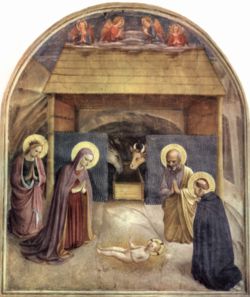
The Nativity refers to the birth of Jesus. The story of Christmas is based on the biblical accounts given in the Gospel of Matthew, namely Matthew 1:18-Matthew 2:12 and the Gospel of Luke, specifically Luke 1:26-Luke 1:56. According to these accounts, Jesus was born to the Virgin Mary, assisted by her husband Joseph, in the city of Bethlehem. The birth took place in a "stable", surrounded by farm animals, and the infant Jesus was laid in a manger. Shepherds from the fields surrounding Bethlehem were told of the birth by an angel, and were the first to see the child.[5] Christians believe that the birth of Jesus fulfilled many prophecies made hundreds of years before his birth.
Remembering or re-creating the Nativity is a central way that Christians celebrate Christmas. The Eastern Orthodox Church practices the Nativity Fast in anticipation of the birth of Jesus, while much of the Western Church celebrates Advent. In some Christian churches, children perform plays re-telling the events of the Nativity, or sing carols that reference the event. Some Christians also display a small re-creation of the Nativity, known as a Nativity scene, in their homes, using figurines to portray the key characters of the event. Live Nativity scenes are also performed, using actors and live animals to portray the event with more realism.[6]
Nativity scenes traditionally include the Three Wise Men, Balthazar, Melchior, and Caspar, although their names and number are not referred to in the Biblical narrative, who are said to have followed a star, known as the Star of Bethlehem, found Jesus, and presented gifts of gold, frankincense, and myrrh.[7]
In the U.S., Christmas decorations at public buildings once commonly included Nativity scenes. This practice has led to many lawsuits, as some say it amounts to the government endorsing a religion. In 1984, the U.S. Supreme Court ruled that a city-owned Christmas display, even one with a Nativity scene, does not violate the First Amendment.[8]
History
Origin of festival
The New Testament does not give a specific date for the birth of Jesus. Sextus Julius Africanus popularized the idea that Jesus was born on December 25 in his Chronographiai, a now lost reference book for Christians written in AD 221.[9] This date is nine months after the traditional date of the Incarnation (March 25), now celebrated as the Feast of the Annunciation.[10] March 25 was also considered to be the date of the vernal equinox and therefore the creation of Adam.[10] Early Christians believed March 25 was also the date Jesus was crucified.[10] The Christian idea that Jesus was conceived on the same date that he died on the cross is consistent with a Jewish belief that a prophet lived an integral number of years.[10]
The identification of the birthdate of Jesus did not at first inspire feasting or celebration. Tertullian does not mention it as a major feast day in the Church of Roman Africa. In 245, the theologian Origen denounced the idea of celebrating Jesus' birthday "as if he were a king pharaoh." He contended that only sinners, not saints, celebrated their birthdays.
The earliest reference to the celebration of Christmas is in the Calendar of Filocalus, an illuminated manuscript compiled in Rome in 354.[2][11] In the east, meanwhile, Christians celebrated the birth of Jesus as part of Epiphany (January 6), although this festival focused on the baptism of Jesus.[12]
Christmas was promoted in the east as part of the revival of Catholicism following the death of the pro-Arian Emperor Valens at the Battle of Adrianople in 378. The feast was introduced to Constantinople in 379, to Antioch in about 380, and to Alexandria in about 430. Christmas was especially controversial in 4th century Constantinople, being the "fortress of Arianism," as Edward Gibbon described it. The feast disappeared after Gregory of Nazianzus resigned as bishop in 381, although it was reintroduced by John Chrysostom in about 400.[2]
Middle Ages
In the Early Middle Ages, Christmas Day was overshadowed by Epiphany, which in the west focused on the visit of the magi. But the Medieval calendar was dominated by Christmas-related holidays. The forty days before Christmas became the "forty days of St. Martin" (which began on November 11, the feast of St. Martin of Tours), now known as Advent.[13] In Italy, former Saturnalian traditions were attached to Advent.[13] Around the 12th century, these traditions transferred again to the Twelve Days of Christmas (December 26 - January 6).[13]. The evening of January 5 was called Twelfth Night, a festival later celebrated in the play of that name by William Shakespeare. The fortieth day after Christmas was Candlemas.
The prominence of Christmas Day increased gradually after Charlemagne was crowned on Christmas Day in 800. This may reflect the influence of Yule, a northern European pagan winter festival which was rescheduled to correspond with Christmas. King William I of England was crowned on Christmas Day 1066.
By the High Middle Ages, the holiday had become so prominent that chroniclers routinely noted where various magnates celebrated Christmas. King Richard II of England hosted a Christmas feast in 1377 at which twenty-eight oxen and three hundred sheep were eaten.[13] The Yule boar was a common feature of medieval Christmas feasts. Caroling also became popular, and was originally a group of dancers who sang. The group was composed of a lead singer and a ring of dancers that provided the chorus. Various writers of the time condemned caroling as lewd, indicating that the unruly traditions of Saturnalia and Yule may have continued in this form.[13] "Misrule" — drunkenness, promiscuity, gambling — was also an important aspect of the festival. In England, gifts were exchanged on New Year's Day, and there was special Christmas ale.[13]
Often the "misrule" got quite out of hand. Revelers would knock at a door and demand the best portion of their host's food and ale, with "severe consequences" if he did not agree.
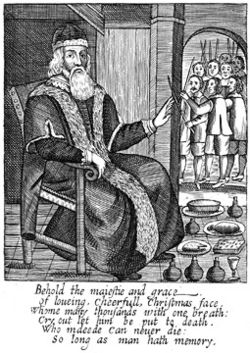
The Reformation and the 1800s
During the Reformation, Protestants condemned Christmas celebration as "trappings of popery" and the "rags of the Beast". The Catholic Church responded by promoting the festival in a more religiously oriented form. Following the Parliamentary victory over King Charles I during the English Civil War, England's Puritan rulers banned Christmas (1647). Pro-Christmas rioting broke out in several cities, and for several weeks Canterbury was controlled by the rioters, who decorated doorways with holly and shouted royalist slogans.[14] The Restoration of 1660 ended the ban, but most of the Anglican clergy still disapproved of Christmas celebration.
In Colonial America, the Puritans of New England disapproved of Christmas; its celebration was outlawed in Boston from 1659 to 1681. At the same time, Christian residents of Virginia and New York observed the holiday freely. Christmas fell out of favor in the United States after the American Revolution, when it was considered an English custom.
By the 1820s, sectarian tension in England had eased and British writers began to worry that Christmas was dying out. They imagined Tudor Christmas as a time of heartfelt celebration, and efforts were made to revive the holiday. Charles Dickens' book A Christmas Carol (1843) played a major role in reinventing Christmas as a holiday emphasizing family, goodwill, and compassion as opposed to communal celebration and hedonistic excess.[15]
Interest in Christmas in America was revived in the 1820s by several short stories by Washington Irving which appear in his The Sketch Book of Geoffrey Crayon and "Old Christmas", and by Clement Clarke Moore's 1822 poem A Visit From St. Nicholas (also known as Twas the Night Before Christmas). Irving's stories depicted harmonious warm-hearted holiday traditions he claimed to have observed in England. Although some argue that Irving invented the traditions he describes, they were widely imitated by his American readers. The numerous German immigrants and the homecomings following the American Civil War also helped promote the holiday. Christmas was declared a U.S. Federal holiday in 1870 .
The 20th century and after
In 1914, the first year of World War I, there was an unofficial truce between German and British troops in France. Soldiers on both sides spontaneously began to sing carols and stopped fighting. The truce began on Christmas Day and continued for some time afterwards.[16] Many stories about the truce include a football game between the trench lines.
Throughout the 20th century, the United States experienced controversy over the nature of Christmas, and its dual status as a religious feast day and a secular holiday of the same name. Some considered the U.S. government's recognition of Christmas as a federal holiday to be a violation of the separation of church and state. This was brought to trial several times, recently including in Lynch v. Donnelly (1984)[8] and Ganulin v. United States (1999).[17] On December 6, 1999, the verdict for Ganulin v. United States (1999) declared that "the establishment of Christmas Day as a legal public holiday does not violate the Establishment Clause because it has a valid secular purpose." This decision was upheld by the U.S. Supreme Court on December 19, 2000. At the same time, many devout Christians objected to what they saw as the vulgarization and cooption of one of their sacred observances by secular commercial society and calls to return to "the true meaning of Christmas" were common.
Debates about Christmas in America continued into the 21st century. In 2005, when commercial interests sought to ameliorate Christians concerned with protecting the sacredness of their holiday and non-Christians uncomfortable with the perceived connection to faith, some Christians, along with American political commentators such as Bill O'Reilly, protested perceiving that it represented the secularization of Christmas rather than its protection. They felt that the holiday was threatened by a general secular trend, or by persons and organizations with an anti-Christian agenda. The perceived trend was also blamed on political correctness.[18]
Santa Claus and other bringers of gifts
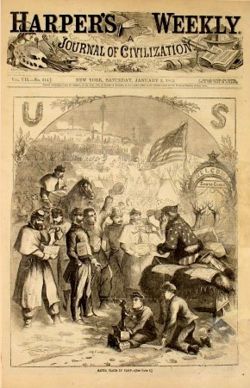
In Western culture, where the holiday is characterized by the exchange of gifts among friends and family members, some of the gifts are attributed to a character called Santa Claus (also known as Father Christmas, Saint Nicholas or St. Nikolaus, Sinterklaas, Kris Kringle, Joulupukki, Weihnachtsmann, Saint Basil and Father Frost).
The popular image of Santa Claus was created by the German-American cartoonist Thomas Nast (1840-1902), who drew a new image annually, beginning in 1863. By the 1880s, Nast's Santa had evolved into the form we now recognize. The image was standardized by advertisers in the 1920s.[19]
Father Christmas, who predates the Santa Claus character, was first recorded in the 15th century, but was associated with holiday merrymaking and drunkenness.[20] In Victorian Britain, his image was remade to match that of Santa. The French Père Noël evolved along similar lines, eventually adopting the Santa image. In Italy, Babbo Natale acts as Santa Claus, while La Befana, is the bringer of gifts and arrives on the eve of the Epiphany. It is said that La Befana set out to bring the baby Jesus gifts, but got lost along the way. Now, she brings gifts to all children.
In some cultures Santa Claus is accompanied by Knecht Ruprecht, or Black Peter. In other versions, elves make the toys. His wife is referred to as Mrs. Claus.
The current tradition in several Latin American countries (such as Venezuela) holds that while Santa makes the toys, he then gives them to the Baby Jesus, who is the one who actually delivers them to the children's homes. This story is meant to be a reconciliation between traditional religious beliefs and modern day globalization, most notably the iconography of Santa Claus imported from the United States.
In Southern Germany, Switzerland, Austria, Alto Adige/Südtirol (Italy) and Liechtenstein the Christkind brings the presents. The German St. Nikolaus is not identical with the Weihnachtsman (who is the German version of Santa Claus). St. Nikolaus wears a bishop's dress and still brings small gifts (usually candies, nuts and fruits) on December 6 and is accompanied by Knecht Ruprecht.
Although many parents around the world routinely teach their children about Santa Claus, some have come to reject this practice, considering it deceptive.[21]
Christmas tree and other decorations
The Christmas tree is often explained as a Christianization of pagan tradition and ritual surrounding the Winter Solstice, which included the use of evergreen boughs,[22] and an adaptation of pagan tree worship.[23] The English language phrase "Christmas tree" is first recorded in 1835[20] and represents an importation from the German language. The modern Christmas tree tradition is believed to have begun in Germany in the 18th century[23] though many argue that Martin Luther began the tradition in the 16th century.[24] From Germany the custom was introduced to England, first via Queen Charlotte, wife of George III, and then more successfully by Prince Albert during the reign of Queen Victoria. Around the same time, German immigrants introduced the custom into the United States.[25] Christmas trees may be decorated with lights and ornaments.
Since the 19th century, the poinsettia has been associated with Christmas. Other popular holiday plants include holly, mistletoe, red amaryllis, and Christmas cactus. Along with a Christmas tree, the interior of a home may be decorated with these plants, along with garlands and evergreen foliage.
In Australia, North and South America, and to a lesser extent Europe, it is traditional to decorate the outside of houses with lights and sometimes with illuminated sleighs, snowmen, and other Christmas figures. Municipalities often sponsor decorations as well. Christmas banners may be hung from street lights and Christmas trees placed in the town square.[26]
In the Western world, rolls of brightly-colored paper with secular or religious Christmas motifs are manufactured for the purpose of wrapping gifts. The display of Christmas villages has also become a tradition in many homes during this season.
Economics of Christmas
Christmas is typically the largest annual economic stimulus for many nations. Sales increase dramatically in almost all retail areas and shops introduce new products as people purchase gifts, decorations, and supplies. In the U.S., the "Christmas shopping season" generally begins on Black Friday, the day after Thanksgiving, though many American stores begin selling Christmas items in October and early November.[27]
In most areas, Christmas Day is the least active day of the year for business and commerce; almost all retail, commercial and institutional businesses are closed, and almost all industries cease activity (more than any other day of the year). In England and Wales, the Christmas Day (Trading) Act 2004 prevents all large shops from trading on Christmas Day. Scotland is currently planning similar legislation. Film studios release many high-budget movies in the holiday season, including Christmas films, fantasy movies or high-tone dramas with high production values.
Modern commercialization
Since the late 1800s the economic importance of Christmas has led to concerns over what is seen as the increasing commercialization of Christmas. The 1823 poem A Visit from Saint Nicholas had popularized the tradition of exchanging gifts and seasonal Christmas shopping began to assume economic importance.[28] In her 1850 book "The First Christmas in New England", Harriet Beecher Stowe wrote a character who complained that the true meaning of Christmas was being lost in a shopping spree.[29]
The importance of the economic impact of Christmas was reinforced in the 1930s when President Franklin D. Roosevelt proposed moving the Thanksgiving holiday date to extend the Christmas shopping season and boost the economy during the Great Depression.[30] Religious leaders protested this move, with a 1931 New York Times roundup of Christmas sermons showing the most common theme as the dangers of an increasingly commercial Christmas.[31]
References
- ↑ The Oxford Dictionary of Christian Church, Oxford University Press, London (1977), p. 280.
- ↑ 2.0 2.1 2.2 2.3 "Christmas", The Catholic Encyclopedia, 1913.
- ↑ Bratcher, Dennis. "The Christmas Season" The Voice, CRI/Voice, Institute, 2006.
- ↑ Oxford English Dictionary
- ↑ Luke 2:1-6
- ↑ Krug, Nora. "Little Towns of Bethlehem", The New York Times, November 25, 2005.
- ↑ Matthew 2:1-11
- ↑ 8.0 8.1 Lynch vs. Donnelly (1984)
- ↑ "Christmas, Encyclopædia Britannica Chicago: Encyclopædia Britannica, 2006.
- ↑ 10.0 10.1 10.2 10.3 "The Feast of the Annunciation", Catholic Encyclopedia, 1998.
- ↑ This document was prepared privately for a Roman aristocrat and is named after an artist who illuminated part of it. The reference to Christmas states, "VIII kal. ian. natus Christus in Betleem Iudeæ". It is in a section based on an earlier manuscript produced in 336.
- ↑ Pokhilko, Hieromonk Nicholas, "The Formation of Epiphany according to Different Traditions
- ↑ 13.0 13.1 13.2 13.3 13.4 13.5 Murray, Alexander, "Medieval Christmas", History Today, December 1986, 36 (12), pp. 31 - 39.
- ↑ Durston, Chris, "Lords of Misrule: The Puritan War on Christmas 1642-60", History Today, December 1985, 35 (12) pp. 7 - 14.
- ↑ Rowell, Geoffrey, "Dickens and the Construction of Christmas", History Today, December 1993, 43 (12), pp. 17 - 24.
- ↑ Baker, Chris, The Christmas Truce of 1914, 1996
- ↑ Ganulin v. United States (1999)
- ↑ Cohen, Adam. "This season's war cry: Commercialize Christmas, or else." The New York Times, December 5, 2005.
- ↑ Mikkelson, Barbara and David P., "The Claus That Refreshes", Snopes.com, 2006.
- ↑ 20.0 20.1 Harper, Douglas, Christ, Online Etymology Dictionary, 2001.
- ↑ Santa: The First Great Lie, essay by Mariane Matera, Citybeat issue 304
- ↑ Robinson, B.A. "All about the Christmas tree: Pagan origins, Christian adaptation, & secular status" ReligiousTolerance.Org, December 13, 2003.
- ↑ 23.0 23.1 van Renterghem, Tony. When Santa was a shaman. St. Paul: Llewellyn Publications, 1995. ISBN 1-56718-765-X
- ↑ Christmas Traditions - The Christmas Tree Custom
- ↑ Morris, Desmond. Christmas Watching. London: Mackays of Chatham, 1992. ISBN 0-224-03598-3
- ↑ Murray, Brian. "Christmas lights and community building in America," History Matters, Spring 2006.
- ↑ Varga, Melody. "Black Friday, About:Retail Industry.
- ↑ usinfo.state.gov “Americans Celebrate Christmas in Diverse Ways” November 26, 2006
- ↑ First Presbyterian Church of Watertown “Oh . . . and one more thing” December 11, 2005
- ↑ usinfo.state.gov “Americans Celebrate Christmas in Diverse Ways”November 26, 2006
- ↑ New York Times “This Season's War Cry: Commercialize Christmas, or Else ”December 4, 2005
